Planting tulips in the fall in the ground
Soil for tulips
The tulip area should be flat, sunny and protected from cold winds. To prevent the tulips from degenerating, you should change the place for the flower bed annually, and in the same area it will be possible to plant a crop no earlier than in 3-4 years. Tulips prefer soil to a neutral or slightly alkaline reaction. Heavy, peaty and acidic soil is not suitable for them. The best soil for tulips is sandy or loamy, moisture-absorbing, fertilized with organic matter under previous crops.
It is necessary to prepare the site 1-2 months before planting: the earth is dug up to a depth of 30-40 cm with the introduction of rotted manure or compost, wood ash and mineral fertilizers. For 1 m² you need to add an average of 2 buckets of compost or humus, 200 g of wood ash, a pound of chalk or dolomite flour (if the soil is acidic) and 100 g of Nitrofoska.
How deep to plant tulips
Before planting tulips, the planting material is sorted out, discarding sluggish, damaged or rotting specimens. Bulbs that can be planted should be flat, free from chips, mold, and gnawing. Dip the planting material for half an hour in a pink solution of potassium permanganate, dry well after that and immediately start planting.
When planting bulbous crops, it is customary to use the following rule: the bulb is buried by three diameters, that is, above the bulb in the hole there should be a layer of earth equal in thickness to two diameters of the bulb. You should know that with too deep planting, the bulbs in the future almost do not form children, and if too shallow, they can freeze in winter.
How to plant tulips in autumn
If the ground is dry, the holes are spilled with water before planting. Do not press the bottom into the soil, you may damage it. The onion laid in the hole is powdered with ash and completely covered with calcined river sand, after which the remaining space is filled with soil.
Try to plant large bulbs closer to the middle of the flower bed, and small ones closer to its edges, then large tulips will not shade small ones. The distance between large bulbs in a row should be at least 10 cm (if you are growing cut flowers), and there may be less spacing between small ones. The row spacing is left 20-25cm wide. If you just plan to grow a beautiful flower bed, plant the bulbs in a row at a distance of 10-20 cm.We recommend that you plant tulips according to varieties, so that later it will be easier for you to care for them, and you do not confuse the planting material of different varieties when digging up.
Planting tulip bulbs
Shallow grooves are made in the beds, into which the onions are then carefully planted.
IMPORTANT! The planting depth of tulips is determined as follows: the height of the onion, multiplied by three. It is not necessary to deeply deepen
The optimum depth for large bulbs is up to 15 cm, for small ones - up to 6-7 cm.
When planting, the type of soil is also taken into account, since it is not worth deepening on heavier soils, but on light and permeable soils, tulips can be planted a couple of centimeters lower.
It is imperative to maintain the distance between the bulbs:
- in large ones - up to 10 cm;
- in medium - up to 6 cm.
It is advisable to spill the soil with a weak solution of potassium permanganate before planting. If the soil is heavy, then the arrangement of simple drainage gives a good effect, when ordinary river sand is poured into the grooves for the bulbs in a small layer. The onions are laid out without pressing them into the ground, while trying to prevent the formation of "pockets" with air under the bottom.
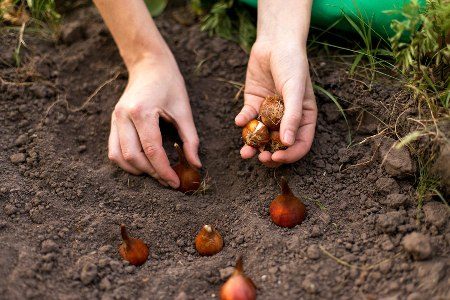
It is recommended to plant tulips by cultivar, as well as taking into account the size of the bulbs.Large and selective specimens should be in the center of the flower beds, while smaller ones should be at the edges. In this case, powerful plants will not block the lighting for small fellows.
The planted onions are sprinkled with soil, and then mulched with humus, crushed compost or peat. No special care needed. If the weather is warm and there is no precipitation, then after about ten days you can shed a little bed of tulips. Later, with the onset of winter cold, it is advisable to cover the bed with tulips with straw or spruce branches. If the winters in the region are not frosty, there will be enough snow cover, but in more severe regions, shelter should be required.
How to properly plant tulips in the fall in open ground
You can plant tulips in different ways, each of which has its own adherents.
The classic way
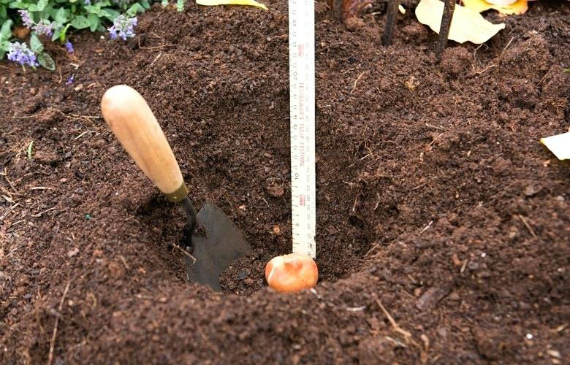 In traditional planting, tulips are planted in separate holes at a distance of 15-20 cm from each other. Then each plant will be able to develop freely without disturbing its neighbors. To obtain a lush flowering, a denser planting is chosen with an interval of 8-10 cm between the bulbs. In this case, the plants need ideal conditions for normal development: fertilized soil, good lighting, proper care.
In traditional planting, tulips are planted in separate holes at a distance of 15-20 cm from each other. Then each plant will be able to develop freely without disturbing its neighbors. To obtain a lush flowering, a denser planting is chosen with an interval of 8-10 cm between the bulbs. In this case, the plants need ideal conditions for normal development: fertilized soil, good lighting, proper care.
The bulbs are pre-sorted by size:
- small specimens are planted to a depth of 6-8 cm separately;
- for large, a depth of 10-12 cm is suitable.
Gardeners have adopted the following rule for planting bulbous flowers: the larger the planting material, the deeper it is planted. Planting depth should be approximately three times the height of the bulbs.
Planting in baskets (containers)
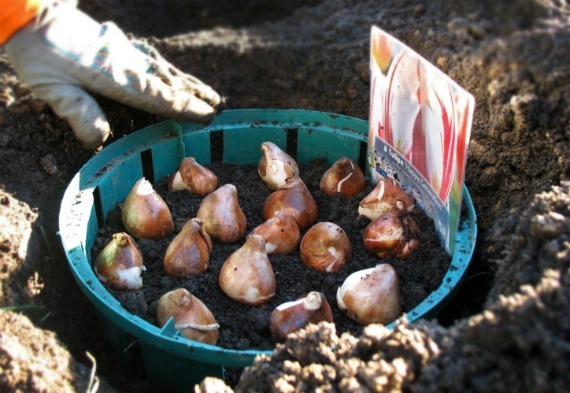 Today, gardening stores sell special plastic baskets for planting bulbous flowers. The containers can be rectangular or round, they have bumpers 10-12 cm high. Planting in such containers is very convenient for the gardener:
Today, gardening stores sell special plastic baskets for planting bulbous flowers. The containers can be rectangular or round, they have bumpers 10-12 cm high. Planting in such containers is very convenient for the gardener:
- Bulbs will not be confused by varieties.
- The basket can be filled with bulbs in advance, and then spend very little time planting all the tulips at the same time.
- If there are mice in the area, the plastic material will make it difficult for them to access the bulbs and the tulips will remain intact.
- When digging for the next year, the onions will definitely not be lost, because they, together with the children, will still be in the same basket.
To remove the bulbs from the ground, it is enough to slightly pry the container from below with a pitchfork and pull it to the surface. Considering all the listed advantages and the low price of plastic containers, this method of planting seems to be more profitable and convenient in comparison with traditional technology.
Longline landing
 A tiered planting of bulbous flowers is also called a "sandwich" because the bulbs are arranged in layers. A variety of primroses are planted in one hole. It can be:
A tiered planting of bulbous flowers is also called a "sandwich" because the bulbs are arranged in layers. A variety of primroses are planted in one hole. It can be:
- hyacinths;
- muscari;
- crocuses;
- tulips.
The bulbs of those varieties that are combined in color shade are pre-selected. Plants can bloom simultaneously or bloom one after the other.
Planting depth depends on the size of the bulbs. Large tulip bulbs are placed in the lowest layer, hyacinths are planted above them, the uppermost layer may consist of crocuses. So that in the future the plants do not interfere with each other, the bulbs are placed on the flower bed in a checkerboard pattern. Such a composition can revive the most boring corner of the garden, settling on it with a juicy spot.
When to plant tulips in spring so they can bloom
In order for the bulbs planted in the ground to germinate and the tulips to bloom in the first year, the planting material is embedded in the soil in early spring.
When choosing a time frame, you must comply with the following requirements:
- planting is carried out from late March to mid-May - the colder the climate in the region, the later the bulbs are embedded in the soil;
- the earth should dry out a little - excess dampness leads to decay of the roots;
- tubers should not be planted during strong winds - it blows the soil off the bulb and can even pull it out of the ground;
- the ground should warm up to + 9 ° С at a depth of at least 10 cm;
- early varieties of flowers are planted in the first half of spring, and late ones from mid-April;
- the air temperature at the time of planting the bulbs in the soil must be at least + 6 ° С.
Did you know? The Netherlands is the world leader in tulip cultivation. More than 3 billion of these vibrant flowers are cut in the country every year.
Preparatory work before planting tulips
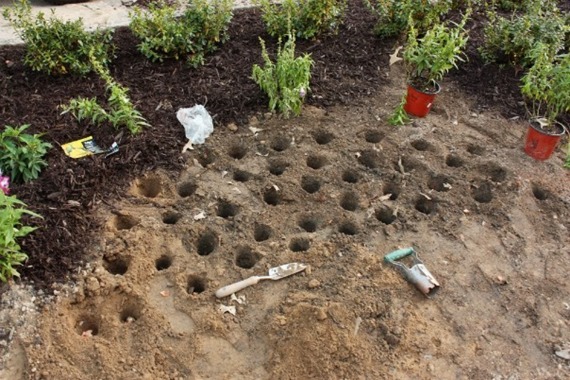 Before proceeding with planting, it is necessary to prepare a place on the site and the planting material itself. The quality of tulip flowering in the spring months largely depends on this.
Before proceeding with planting, it is necessary to prepare a place on the site and the planting material itself. The quality of tulip flowering in the spring months largely depends on this.
Seat selection
The brightness of the color and the size of the buds largely depend on where the tulips will be planted. This is a light-loving culture. In insufficient light, the flower stalks will be too elongated, thin and curved, and the buds themselves will be paler than the characteristics of the variety promise.
Do not plant tulips in lowlands, where water often accumulates in spring. From excess moisture in the soil, the bulbs can easily rot. It is desirable that the site be protected from winds; these flowers also do not like drafts.
Ground requirements
Soil with a neutral or slightly alkaline reaction is best suited for planting tulips. In acidic soil, the culture can give "blind" (not later blooming) buds. Prepare the flower bed in advance, about 1-2 months before planting the bulbs. The earth is dug onto the bayonet of the shovel.
If the soil is infertile, fertilize it. For this purpose, it is good to use a special commercial fertilizer for bulbous flowers. Experienced summer residents prefer to prepare top dressing on their own, mixing compost, wood ash, dolomite flour, superphosphate, potassium sulfate, ammonium nitrate.
Preparing tulip bulbs for planting
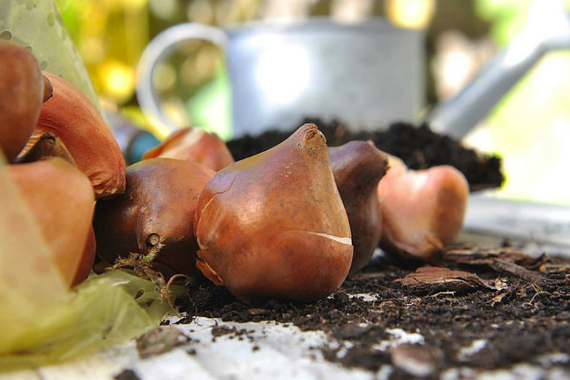 The bulbs should be inspected carefully before planting. They must be free of any traces of mold and any damage. A high-quality bulb is distinguished by a dense bottom with root primordia.
The bulbs should be inspected carefully before planting. They must be free of any traces of mold and any damage. A high-quality bulb is distinguished by a dense bottom with root primordia.
On the eve of planting, the material must be etched. This procedure will protect tulips from most bacterial and fungal diseases. The simplest method is to immerse the bulbs for half an hour in a weak solution of potassium permanganate. You can also use "Fundazol", "Vitaros" as a dressing agent.
Planting care
There are many reasons why tulips are planted in the fall. To understand, you need to delve into the physiology of a given plant. For rapid growth, a tulip needs long-term cooling.
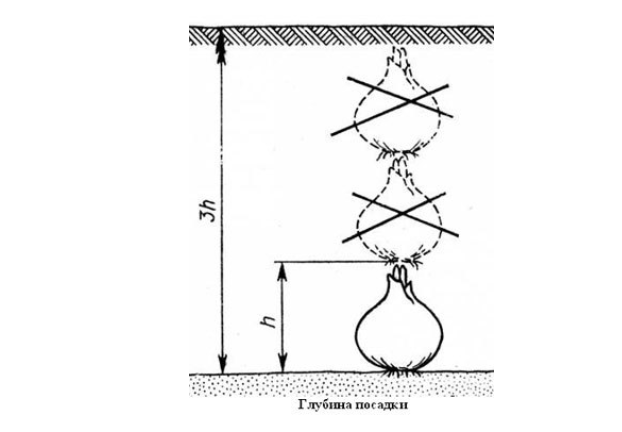
Interesting! Planting and caring for a garden hydrangea
The thing is that after lowering the temperature, the bulb produces an active substance that accelerates the growth rate, and also improves the quality of the flower itself. In nature, wild tulips begin to sprout almost simultaneously with snowdrops, immediately after the last snow melts.
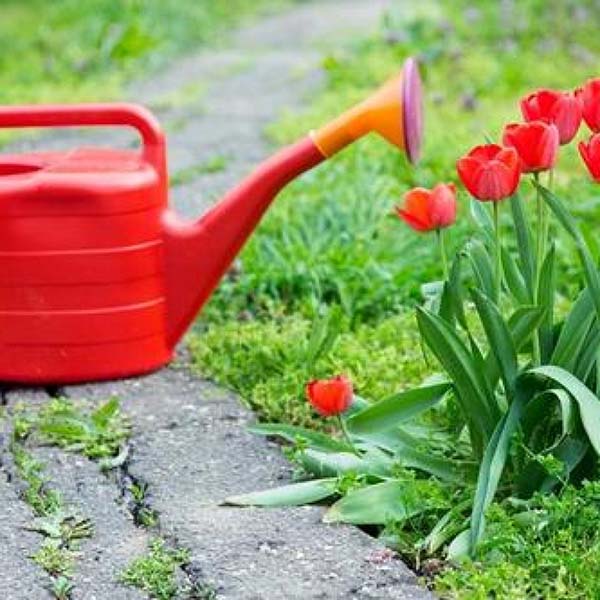
It is also worth noting that with early spring planting of the bulbs, the rooting period takes a long time and the plant appears very late. Sometimes, tulips do not even have time to bloom and die with the arrival of summer. Also, when planting bulbs in spring, there is a high risk of disease. The high temperature creates favorable conditions for the development of Fusarium.
Special flower
Experienced flower growers know that tulip bulbs can be planted in the ground in early spring and autumn. But the spring planting, due to the botanical characteristics of these plants, does not give such a rapid flowering of tulips as the autumn one. This is due to the specifics of the life cycle of wild plants, which include tulips.
In early spring, tulips start growing and in a matter of days, luxurious buds appear on green stems. The flowering time is fleeting, and as soon as the sun's rays begin to warm more strongly, the tulips wither, the leaves begin to dry out.The bulbs are dug up and stored until autumn.

In autumn, when everything around is getting ready for wintering, the sleep of tulip bulbs stops. They must be planted in the ground so that they have time to form a root system before the cold weather, store nutrients and in early spring are ready to please everyone with new beautiful buds.
When planting in spring, plants need to do everything at an accelerated pace, and therefore the seedlings will be less strong, and the flowering will not be so luxurious.
When to plant tulips in autumn
Usually, in the middle lane, the month of planting tulips is September, the second half of it, because the first may still be too warm. Or even October, if September was too warm. In general, for planting, we are guided by the air temperature.
If it is higher, then the planted bulbs will wake up and start growing, but we do not need this. Because then they will inevitably die from winter frosts.
It is necessary that they remain sleeping in the ground until spring.
Therefore, we plant when it is already very cool. In the southern regions, planting dates can be shifted until November.
Interestingly, note that the price of tulip and daffodil bulbs drops sharply in October. They can be purchased at a huge discount for mere pennies. This is a good time for enthusiastic gardeners of the middle lane and southern regions to purchase this inexpensive planting material and plant it.
This is a good time for enthusiastic gardeners in the middle lane and southern regions to purchase this inexpensive planting material and plant it.
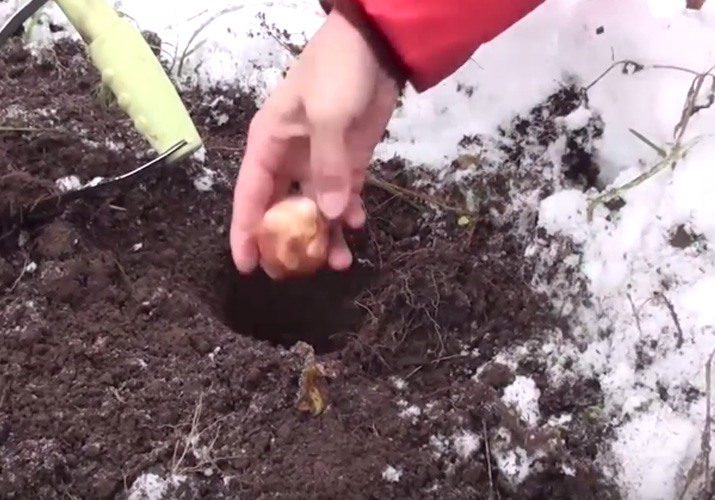
That's right, tulips are quite cold-resistant and can be planted even at the end of October, at temperatures close to zero.
Since in the middle lane the winter is with little snow, with thaws, the flower bulbs will have time to take root.
They will germinate well in spring, just bloom a little later than their counterparts planted in September.
But it's even great, when they all have already faded, you will still have tulips. So take note if you have a suitable region. In Siberia, of course, you can't experiment like that, frosts come too early.
Please note that tulips are not planted in spring, this is against their nature. Their time is autumn. So we do not store the bulbs until spring, we plant
So we don't store the bulbs until spring, we plant them.
Storage methods and rules

After harvesting at home, you need to save the bulbs until about autumn (mid-September), when the moment of planting comes.
To prevent the heads from losing their vitality, it is important to choose the right place and storage conditions. To prevent tulip bulbs from sprouting, carefully monitor the level of humidity.
Creation of favorable conditions
It is important to ensure high temperatures for the first month of storage. In good weather, you can leave the bulbs outside under a canopy
In the room where tulips are stored, the following conditions must be met:
- temperature is not lower than +23 ° C;
- humidity level - 50-70%;
- high-quality ventilation.
If tulips are left indoors without changing the air or in high humidity, mold can develop on them. Such specimens are unsuitable for planting.
In August, storage conditions change slightly. The room temperature should not exceed +20 ° C. Closer to September, it is reduced to + 15-16 oC. The humidity level should remain low, so the containers of bulbs should be removed from the street and transferred to a closed, ventilated place.
A gradual change in the temperature regime is mandatory, as it is due to the needs of the culture. In the first month in the warmth, a flower arrow is laid, then a replacement bud. In the next stage, the leaves and future parts of the flower are formed. If you do not observe the temperature regime, then the plant may not bloom next spring or expel unopened buds.
Choosing the right place
Dried and prepared bulbs are placed in wooden or cardboard boxes.It is best not to sprinkle the planting material with a slide, but carefully distribute in one layer.
You can store tulips in different rooms:
- in the attic;
- in the barn;
- in the country;
- on the balcony;
- and even on the windowsill.
The main thing is to comply with the required conditions and prevent light from entering the bulbs. If in a country house boxes with tulips are placed in the attic, then they are protected from rodents.
Useful articles from the "Bulbous" section:
Useful articles for the gardener:
- Harvesting asparagus beans: timing, storage
- Jerusalem artichoke
- What to sow and plant in the garden and vegetable garden in August
- Zephyranthes: planting, care at home and outdoors
- How to get rid of aphids on currants: effective methods
- When to harvest walnuts: timing, storage
- Mushroom picker calendar 2020: when to collect, auspicious days
- Autumn work in the garden and garden: what needs to be done
- Do I need to dig a garden before winter: timing, what fertilizers to apply
- Apricot compote for the winter: delicious and simple recipes


